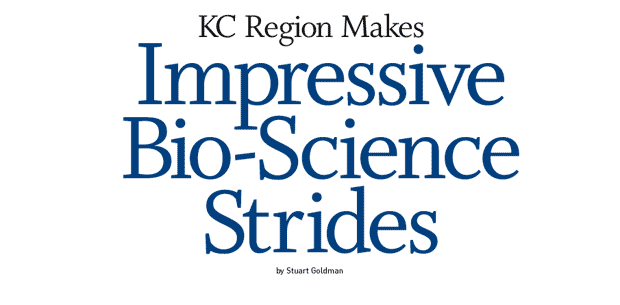Cancer. Childhood obesity. Heart disease. Bioterrorism.
These are just some of the ills and evils that companies throughout the Missouri-Kansas region are combating on a daily basis. This combat has necessitated the area becoming a growing force in the biotechnology industry.
According to the Kansas City Area Development Council, Kansas City has more than 200 bioscience companies that employ more than 20,000 people, representing two percent of the city’s total workforce. Companies such as Bayer HealthCare, TEVA Neuroscience, Synbiotics Corp., and Fort Dodge Animal Health are just some of the companies that have come to the Kansas City area in recent years. In addition, universities and bioscience companies have built or planned more than $1.2 billion in expansion projects in the last few years as well.
The key expansion project in Kansas City’s near future is being planned at The Stowers Institute for Medical Research. The Institute is strongly considering ad-ding 600,000 square feet to its campus, an estimated $300 million project that could be completed by 2008 or 2009.
“We’re viewed both nationally and internationally as one of the rapidly emerging metropolitan areas in the life sciences, relative to becoming a center of excellence,” said Bill Duncan, president of the Kansas City Area Life Sciences Institute.
The KCALSI is hoping to increase life sciences research in Kansas City to a $500 million annual business by 2010. One of the projects that the KCALSI is facilitating is the Center for Physical Activity, Nutrition and Weight Management, which is expected to open early 2008 at 22nd and Holmes Road.
The project, which involves Children’s Mercy Hospital and the University of Kansas, is under the direction of KU professor Joseph Donnelly, who said the vast majority of the center’s work will be in the community. Its offices will house the investigators, but they will take their work out to the people. “The primary business is not to bring in people and ‘treat’ them,” added Donnelly.
The primary objective of the project is to fight childhood obesity which afflicts 24.3 percent of all Kansas children and 32 percent of all Missouri children.
“That project has a lot of appeal to us,” Duncan said. “Not only is it treating the children in the region, but also the research and collaboration that would result from that has national implications.”
Duncan also hopes that Kansas City will become one of the leading cancer centers in the country, an effort spearheaded by KU and the KU Medical Center, whose program “would be able to provide the cancer care equivalent to any place in the country.”
The University of Kansas Cancer Center is hoping to achieve National Cancer Institute designation by 2016. KU estimates the cost to reach that goal will be $1.1 billion, but $770 million already has been identified. The economic impact on the region after 2016 could be $1.3 billion.
Duncan would also like to see more incubators for companies in the Kansas City area. The $700,000 center for Proteon Therapeutics, which opened last month west of the Country Club Plaza, has a small incubator.
The focus of Kansas City’s Midwest Research Institute is defense, life sciences and energy, along with engineering and agriculture and food safety.
Linda Cook, director of communications for MRI, said that the institute is researching censors, assays and water sampling technologies that reveal contaminants.
According to Cook, 84 percent of MRI’s work is funded from federal sources, with the rest coming from commercial and state sources. For the fiscal year 2006, MRI generated a total revenue of more than $283 million, which includes MRI research operations and its energy lab in Golden, Colo.
The Department of Homeland Security has targeted Missouri and Kansas as two of just 11 states that are still in the running to land the DHS’s proposed National Bio and Agro-Defense Facility (NBAF). There are 18 proposed sites overall, including two in Kansas (Fort Leavenworth and Manhattan) and one in Missouri (Columbia). The DHS is expected to announce the site in 2008, with the facility up and running by 2013 or 2014.
“We feel really good that we’re still in consideration,” said Jim Guikema, vice provost for graduate research at Kansas State University. “This will be a research facility that will be designed for disease and animal health issues that are critical. This has the opportunity to draw our communities together.”
Kansas City continues to be a leader in animal health. As reported on the KC Animal Health Corridor web site, regional Kansas City companies account for nearly 30 percent of total sales in the $14.2 billion global animal health market.
In research, animal health is becoming more important, especially as it relates to human health’. “The new buzzword is the ‘one-health’ model,” said Ron Trewyn, vice provost for research and the dean of the graduate school at Kansas State University. “So you have animal health and human health. A lot of commonalities and a lot of the developments that are applied to humans come out of the animal research realm.”
“Clearly, the diseases of animals and people are very similar,” Trewyn added. “You can make great strides that can cross over from one to the other.”
«January 2007 Edition
